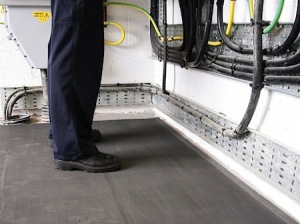A reminder about electrical safety rubber matting standards change

Typical applications for electrical safety matting include when working in front of switchboards, machine control gear, in plant rooms and lift control gear rooms, and also as portable protection for site engineers working on live equipment. BigDug
Today in the UK, electrical safety matting, which is an insulated floor covering that helps protect contractors working on electrical installations from the dangers of shock, has to comply with BS EN 61111:2009. The previous standard, replaced some time ago, was BS 921: 1976, but it seems that this is not as widely known as it should be. By James Hunt:
If your electrical safety matting still only complies with the old and superseded BS 921:1976, rather than its successor BS EN 61111:2009, it no longer conforms with the current safety standards. This could leave firms open to prosecution if an accident occurred.
Electrical safety matting is a vital part of electrical safety and is typically used for protection around areas where high voltage (HV) equipment – such as a switchboard – is being used and worked upon, but it is also available for working on low and medium voltage (LV and MV) equipment.
Typical applications include when working in front of switchboards, machine control gear, in plant rooms and lift control gear rooms, and also as portable protection for site engineers working on live equipment.
As part of a firm’s risk assessment, if there is any potential risk of shock, then electrical safety matting (sometimes known as insulating matting or switchboard matting) is recommended in the HSE’s Safe Working Practices for Electricity at Work document, HSG85 (third edition), where it reference BS EN 61111: 2009 (Live working. Electrical insulating matting British Standards Institution). Its use will help prevent earth contact through the floor.
The HSE (www.hse.gov.uk) also recommends the use of insulated matting in relation to electrical hazards when welding, and for electrical safety when working in quarries, construction sites and other similar activities.
Choose with care
Electrical safety mats are made specifically for the purpose of shock prevention and are tested to withstand certain specified voltages, so it is crucial that the right level of protection is allowed for in line with the voltage of the equipment that is being worked on.
BS EN 61111:2009 v BS 921:1976
BS 921:1976 was withdrawn because it conflicted with the now current UK national standard of electrical insulating matting, which is BS EN 61111:2009. Under the auspices of BS EN 61111:2009, the matting must withstand a greatly extended testing regime compared with the old BS 921:1976 standard.
Compliance with BS EN 61111:2009 means that the matting will have a number of benefits over the BS 921: 1976 variety, as it is oil and acid resistant, flame retardant, lighter in weight, and there are a various classes for different voltage applications.
It is believed that matting manufactured to the superseded BS 921: 1976 regulation is still available, as it is suitable for its originally intended use in the UK. Now, however, it is known as ‘Electrical Safety Matting’ tested to 650V working insulation.



